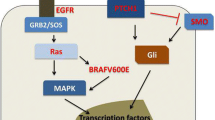Abstract
Background
Odontogenic tumors (OTs) comprise a group of heterogeneous lesions ranging from hamartomatous or non-neoplastic tissue proliferation to benign or malignant neoplasms with metastatic potential. OTs are derived from epithelial, ectomesenchymal, and/or mesenchymal elements of tooth-forming (“odontogenic”) tissues, which show variable clinical and histopathological features.
Objective
Herein, the authors summarize the World Health Organization (WHO) 2022 classification of OTs and further highlight diagnostic tips and differential clues for the most common OTs.
Conclusion
OTs may not be commonly encountered in the daily practice of many pathologists. This makes their diagnosis challenging as there is little practice in understanding the features required for their classification. However, diagnosing the vast majority of these lesions is not difficult provided the following aspects are considered: 1) the general knowledge of tooth development; 2) a few key histological observations; 3) very basic knowledge of the clinical and especially the radiographic features with which they are associated.
Zusammenfassung
Hintergrund
Odontogene Tumoren (OT) umfassen eine Gruppe heterogener Läsionen, die von hamartomatösen oder nichtneoplastischen Gewebeproliferationen bis hin zu benignen oder malignen Neoplasmen mit Metastasierungspotenzial reichen. OT entstehen aus epithelialen, ektomesenchymalen und/oder mesenchymalen Elementen zahnbildender („odontogener“) Gewebe und weisen unterschiedliche klinische und histopathologische Merkmale auf.
Ziel der Arbeit
Die Autoren haben hier die Klassifikation der Weltgesundheitsorganisation (WHO) aus dem Jahr 2022 für OT zusammengefasst wie auch diagnostische Hinweise und Differenzialdiagnosen für OT aufgezeigt.
Schlussfolgerung
In der täglichen Praxis vieler Pathologen sind OT nicht unbedingt häufig anzutreffen. Dies macht ihre Diagnose schwierig, da es wenig Erfahrungen im Verständnis der für ihre Klassifizierung erforderlichen Merkmale gibt. Die Diagnose der überwiegenden Mehrheit dieser Läsionen ist jedoch nicht schwierig, wenn man Folgendes berücksichtigt: 1) das allgemeine Wissen über die Zahnentwicklung, 2) einige wichtige histologische Beobachtungen, 3) sehr grundlegende Kenntnisse der klinischen und insbesondere der röntgenologischen Merkmale, mit denen sie einhergehen.






Similar content being viewed by others
References
Ogle SARBOE (2020) Odontogenic tumors. Dent Clin North Am 64(1):121–138
Regezi J, Schiubba JJ, Jordon JRK (2012) Oral pathology. Clinical pathologic correlations, 6th edn. Elsevier-Saunders, St. Louis, pp 270–277
Robinson RA (2017) Diagnosing the most common odontogenic cystic and osseous lesions of the jaws for the practicing pathologist. Mod Pathol 30(s1):96–S103
International Agency for Research on Cancer (ed) (2022) WHO classification of tumors editorial board. Head and neck tumors, 5th edn. WHO classification oftusssss series, vol 9. International Agency for Research on Cancer, Lyon
Wright VMJM (2022) Update from the 5th edition of the World Health Organization classification of head and neck tumors: odontogenic and maxillofacial bone tumors. Head Neck Pathol 16(1):63–75
Mendenhall WM, Werning JW, Fernandes R, Malyapa RS, Mendenhall NP (2007) Ameloblastoma. Am J Clin Oncol 30:645–648
Hunter KD, Niklander S (2020) Pitfalls in odontogenic lesions and tumors: a practical guide. Diagn Histopathol 26(4):173–180
Chrcanovic BR, Brennan PA, Rahimi S, Gomez RS (2018) Ameloblastic fibroma and ameloblastic fibrosarcoma: a systematic review. J Oral Pathol Med 47(4):315–325
Chrcanovic BR, Gomez RS (2019) Odontogenic myxoma: An updated analysis of 1,692 cases reported in the literature. Oral Dis 25(3):676–683
Giridhar P, Mallick S, Upadhyay AD, Rath GK (2017) Pattern of care and impact of prognostic factors in the outcome of ameloblastic carcinoma: a systematic review and individual patient data analysis of 199 cases. Eur Arch Otorhinolaryngol 274:3803–3810
Niu Z, Li Y, Chen W et al (2020) Study on clinical and biological characteristics of ameloblastic carcinoma. Orphanet J Rare Dis 15:316
Author information
Authors and Affiliations
Corresponding author
Ethics declarations
Conflict of interest
S. E. Gültekin and R. Büttner declare that they have no competing interests.
For this article no studies with human participants or animals were performed by any of the authors. All studies mentioned were in accordance with the ethical standards indicated in each case.
The supplement containing this article is not sponsored by industry.
Additional information

Scan QR code & read article online
Rights and permissions
About this article
Cite this article
Gültekin, S.E., Büttner, R. Clinical and pathomorphological aspects of odontogenic tumors. Pathologie 43 (Suppl 1), 86–93 (2022). https://doi.org/10.1007/s00292-022-01150-9
Accepted:
Published:
Issue Date:
DOI: https://doi.org/10.1007/s00292-022-01150-9




